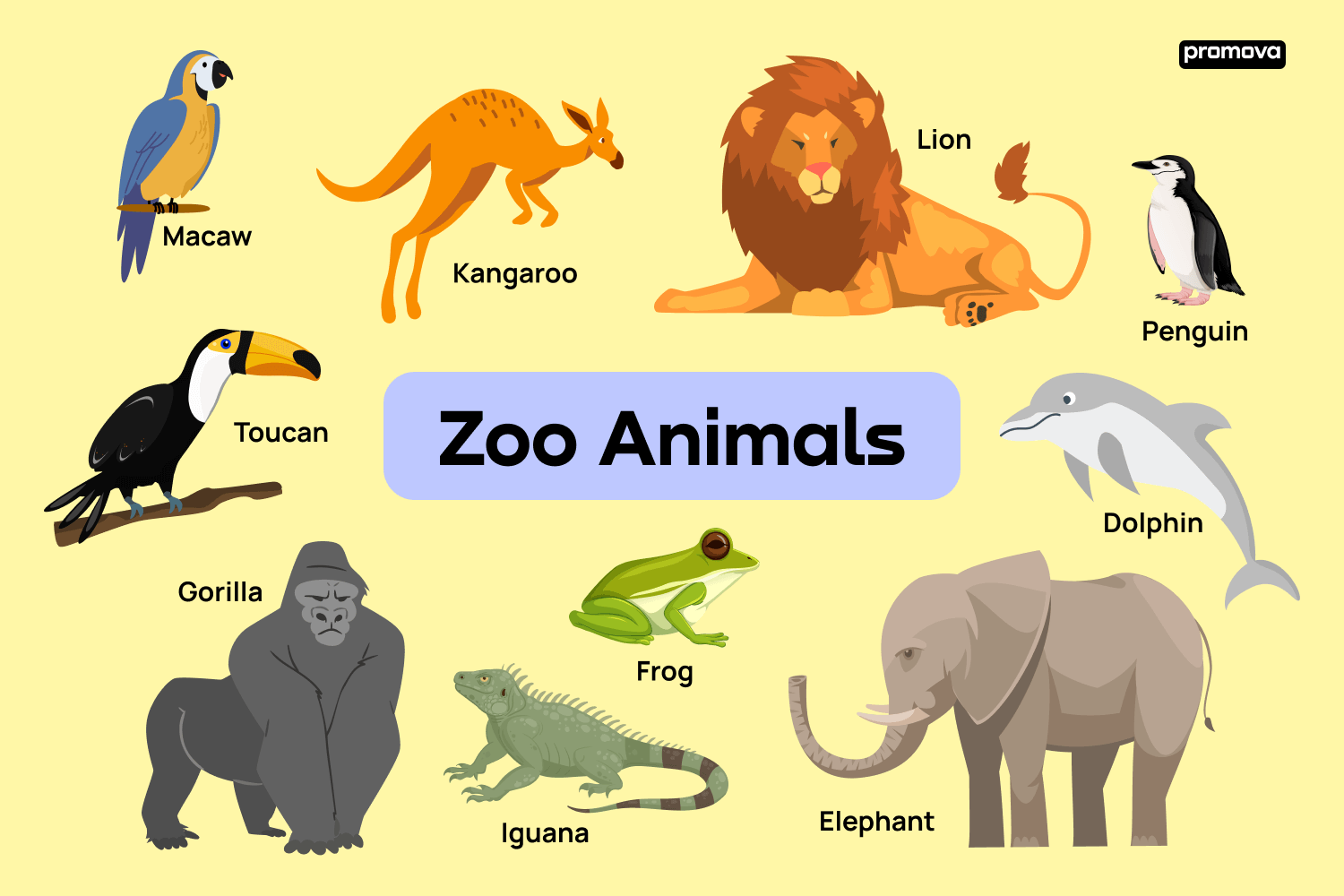Zoo Animals Vocabulary
Contents
Enhance your English vocabulary with the world of zoo animals! This article will present a comprehensive zoo animals list, including different types of animals at the zoo, staff roles, and facilities you might find in these unique habitats. 
Types of Zoo Mammals
Mammals are warm-blooded vertebrates that possess hair or fur. After this section, you'll be able to describe various types of zoo mammals in English with ease.
- Elephant: A large, gray mammal known for its long tusks and trunk.
- Lion: Known as the "King of the Jungle", a big cat with a golden coat and males have a distinctive mane.
- Kangaroo: A marsupial from Australia, known for its hopping movement and pouch for carrying young.
- Giraffe: The tallest living terrestrial animal with a long neck and legs, and a unique spotted pattern on its skin.
- Panda: Known for their black and white fur, these mammals feed mostly on bamboo and are native to China.
- Rhinoceros: A large, herbivorous mammal with one or two horn-like protrusions on their nose.
- Zebra: A wild horse-like animal recognized for its unique black and white stripes.
- Koala: An arboreal herbivorous marsupial native to Australia, often mistaken for a bear.
- Gorilla: A large, highly intelligent primate with black fur, native to the forests of central Sub-Saharan Africa.
- Chimpanzee: A highly intelligent primate known for its ability to use tools and social nature, native to the rainforests of West and Central Africa.
- Leopard: A big cat known for its rosette patterned fur and exceptional climbing abilities.
- Tiger: The largest species of the cat family, recognized for its orange coat with black stripes.
- Platypus: An unusual mammal that lays eggs, has a duck-like bill, and is native to Australia.
- Arctic Fox: A small white fox native to Arctic regions, known for its ability to survive in extremely cold conditions.
- Dolphin: A highly intelligent marine mammal known for its playful behavior.
That completes the journey through the world of zoo mammals. With these new words in your vocabulary, you'll be able to talk about different mammals at the zoo with ease and clarity.
Types of Zoo Birds
There is a great variety of birds in the zoo. By the end of this section, you'll be equipped with terms to describe these beautiful animals.
- Flamingo: Known for their vibrant pink feathers and long, thin legs.
- Peacock: Renowned for their dazzling tail feathers, which they display in a fan-like formation.
- Toucan: Recognized for its large, colorful bill and its bright feathered body.
- Eagle: A large bird of prey known for its powerful build, heavy beak, and keen eyesight.
- Penguin: Flightless birds known for their waddling walk and adept swimming abilities.
- Parrot: Known for their bright feathers, ability to mimic human speech, and strong curved beak.
- Ostrich: The world's largest bird, native to Africa, and recognized for its long neck and legs.
- Pelican: Known for their large throat pouch used for catching fish and draining water before swallowing.
- Owl: Nocturnal birds of prey known for their round faces, rotating necks, and hooting sounds.
- Macaw: A large parrot with brightly colored feathers and a strong curved beak.
- Kookaburra: Known for its distinctive "laughing" call, native to Australia and New Guinea.
- Hornbill: Recognized for its large, curved bill often with a noticeable casque.
- Stork: Tall, long-legged wading birds with long, stout bills.
- Kingfisher: Known for their bright colors and large beak used for fishing.
- Hummingbird: Small birds known for their rapid wing-flapping rates and ability to hover in mid-air.
Now that you're familiar with a range of bird species, you can describe various zoo birds in English.
Types of Zoo Reptiles
Reptiles are cold-blooded creatures often known for their scales and ability to lay eggs. By learning the vocabulary in this section, you'll be able to converse about zoo reptiles more confidently:
- Crocodile: A large aquatic reptile with a powerful jaw and long, narrow body.
- Python: A large, non-venomous snake known for its ability to constrict its prey.
- Tortoise: A reptile with a hard protective shell, known for its slow pace.
- Chameleon: A distinctive lizard known for its ability to change color.
- Komodo Dragon: The largest living species of lizard, found on the Indonesian islands.
- Iguana: A large, herbivorous lizard known for the row of spines running down its back.
- Gecko: A small lizard known for its adhesive toe pads which enable it to climb smooth surfaces.
- Alligator: An aquatic reptile with a powerful tail and armored body, similar to a crocodile but with a broader snout.
- Gila Monster: A venomous lizard native to the southwestern United States and northwestern Mexican state of Sonora.
- Monitor Lizard: A large lizard known for its strong body, sharp claws, and long tongue.
- Turtle: A reptile with a bony or cartilaginous shell from which it can protrude its head and limbs.
- Rattlesnake: A venomous snake recognized by the rattle on its tail, which it shakes when threatened.
- Boa Constrictor: A large snake known for killing its prey by constricting and suffocating them.
- Frog: Although commonly mistaken as a reptile, it's an amphibian. Known for its hopping motion, slimy skin, and vocal sounds.
- Salamander: Like the frog, it's an amphibian, not a reptile. Known for its lizard-like appearance and regenerative abilities.
With these new words in your arsenal, you're well-equipped to discuss different types of reptiles. Keep these terms in mind when you encounter these creatures at the zoo.
14
Types of Zoo Fish
Ranging from the small clownfish to the large shark, you'll easily define different fish in the zoo with this vocabulary:
- Clownfish: A small, brightly colored fish recognized due to its symbiotic relationship with anemones.
- Lionfish: A fish known for its venomous spines and unique zebra-like appearance.
- Pufferfish: Known for its ability to inflate its body when threatened.
- Shark: A group of elasmobranch fish characterized by a cartilaginous skeleton, five to seven gill slits on the sides of the head, and pectoral fins that are not fused to the head.
- Stingray: A flat-bodied fish known for its long tail with a venomous stinger.
- Angelfish: Known for their distinct triangular shape and brightly colored patterns.
- Seahorse: Recognized by their horse-like head, prehensile tail, and male pregnancy.
- Piranha: A small but fierce fish known for its sharp teeth and potent bite.
- Eel: Known for their elongated bodies, diversity in color, and some species' electric abilities.
- Koi: A domesticated and ornamental variety of a carp that is often kept for decorative purposes in outdoor ponds.
- Tuna: A large and fast-swimming fish that has a streamlined body.
- Swordfish: Known for their long, pointed bill, or "sword," and their speed and agility.
- Tetra: Small, brightly colored freshwater fish that are often kept in aquariums.
- Discus: A genus of cichlids native to the Amazon river basin, renowned for their bright colors and disk-like shape.
- Guppy: A popular freshwater aquarium fish species due to its hardiness and vibrant colors.
The diverse world of fish is now part of your vocabulary. You can now use these terms to talk about the various types of fish you might encounter, whether at a zoo, an aquarium, or in nature documentaries.
Types of Zoo Invertebrates
These creatures lack a backbone and are incredibly diverse. Once you've gone through this section, you'll be able to describe a variety of these creatures with your expanded vocabulary.
- Tarantula: A large, hairy spider known for its size and vibrant colors.
- Butterfly: Insects known for their large, often brightly colored wings.
- Octopus: A marine animal known for its eight arms, intelligence, and ability to change color and texture.
- Scorpion: An arachnid with a pair of grasping pincers and a narrow, segmented tail often carried over the back, ending with a venomous stinger.
- Jellyfish: Marine animals recognized by their gelatinous, umbrella-shaped bell and trailing tentacles.
- Lobster: A large marine crustacean with a strong, cylindrical body, muscular tail, and two large claws.
- Beetle: An insect with a hard exoskeleton, including the brightly colored ladybirds and destructive pests like the bark beetles.
- Ant: Small insects known for their complex societies and ability to work together.
- Snail: Known for their coiled shells, slow movement, and slimy trail.
- Crab: A crustacean with a short tail, broad carapace, and two large claws.
- Starfish: Also known as sea stars, they are marine animals known for their star-like appearance.
- Coral: A group of marine invertebrates that often live in compact colonies of many identical individual polyps.
- Sea Anemone: Predatory invertebrates that resemble flowers but are capable of catching fish and small animals with their tentacles.
- Grasshopper: Insects recognized for their ability to jump high and long distances.
- Centipede: Arthropods known for their many pairs of legs and elongated bodies.
Armed with these terms, you can confidently describe various zoo invertebrates.
Zoo Staff and Roles
There are many hardworking people who keep the zoo running. Understanding these roles can enhance your zoo visits and help you appreciate the work that goes into animal care.
- Zookeeper: Responsible for the daily care and feeding of the animals in the zoo.
- Veterinarian: A medical professional who takes care of the health needs of the animals.
- Aquarist: A specialist who cares for fish and other marine animals.
- Curator: A professional who manages the zoo's animal collection and acquisition.
- Education Officer: An individual who develops and delivers educational programs for zoo visitors.
- Animal Trainer: Trains animals for rides, shows, or interactions with visitors.
- Conservation Scientist: Researchers who study the animals to support their conservation.
- Zoo Director: The individual responsible for overseeing the entire operations of the zoo.
- Horticulturist: Maintains the plants and landscape within the zoo.
- Animal Nutritionist: Specializes in the diet and feeding of zoo animals.
Knowing the roles of various staff members can enrich your understanding of what goes on behind the scenes at a zoo. Now, you have the vocabulary to appreciate and discuss the people who make zoos possible.
Zoo Facilities and Areas
Lastly, explore the various facilities and areas in a zoo. Each serves a different purpose and houses specific types of zoo animals.
- Aviary: An enclosure for keeping birds.
- Aquarium: A facility where aquatic animals are kept and displayed.
- Reptile House: A building where reptiles are kept for display.
- Nocturnal House: A facility where the light cycle has been reversed to accommodate nocturnal animals.
- Insectarium: A specialized facility for keeping and displaying insects.
- Amphibian Center: A place where amphibians are kept for study and display.
- Aquatic Show Arena: A place where trained aquatic animals, like dolphins or sea lions, perform.
- Tropical Rainforest Exhibit: An exhibit designed to replicate a rainforest environment.
Now that you're acquainted with these terms, you can converse about different zoo environments in English. Your understanding of these habitats will enhance your next visit to a zoo.
Conclusion
Expanding your vocabulary with a focus on zoo-related terminology not only equips you with a broader linguistic range but also enhances your understanding of the world of animals. This zoo animals list offers a glimpse into the rich variety of animals at the zoo, the roles that contribute to their welfare, and the diverse facilities designed to make their and your experience unique. So, the next time you visit a zoo, you'll appreciate it even more, knowing the names and characteristics of different small zoo animals and the bigger ones too!



Comments